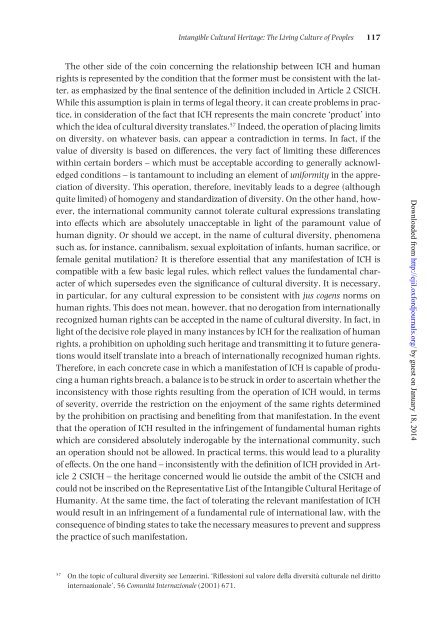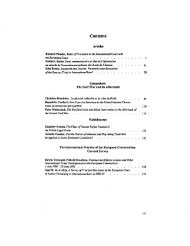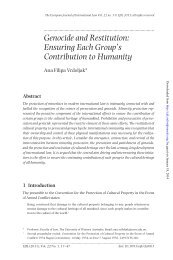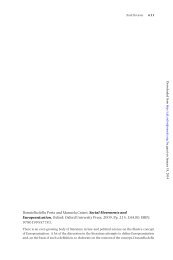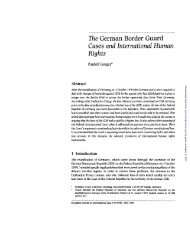Intangible Cultural Heritage - European Journal of International Law
Intangible Cultural Heritage - European Journal of International Law
Intangible Cultural Heritage - European Journal of International Law
You also want an ePaper? Increase the reach of your titles
YUMPU automatically turns print PDFs into web optimized ePapers that Google loves.
<strong>Intangible</strong> <strong>Cultural</strong> <strong>Heritage</strong>: The Living Culture <strong>of</strong> Peoples 117<br />
The other side <strong>of</strong> the coin concerning the relationship between ICH and human<br />
rights is represented by the condition that the former must be consistent with the latter,<br />
as emphasized by the final sentence <strong>of</strong> the definition included in Article 2 CSICH.<br />
While this assumption is plain in terms <strong>of</strong> legal theory, it can create problems in practice,<br />
in consideration <strong>of</strong> the fact that ICH represents the main concrete ‘product’ into<br />
which the idea <strong>of</strong> cultural diversity translates. 57 Indeed, the operation <strong>of</strong> placing limits<br />
on diversity, on whatever basis, can appear a contradiction in terms. In fact, if the<br />
value <strong>of</strong> diversity is based on differences, the very fact <strong>of</strong> limiting these differences<br />
within certain borders – which must be acceptable according to generally acknowledged<br />
conditions – is tantamount to including an element <strong>of</strong> uniformity in the appreciation<br />
<strong>of</strong> diversity. This operation, therefore, inevitably leads to a degree (although<br />
quite limited) <strong>of</strong> homogeny and standardization <strong>of</strong> diversity. On the other hand, however,<br />
the international community cannot tolerate cultural expressions translating<br />
into effects which are absolutely unacceptable in light <strong>of</strong> the paramount value <strong>of</strong><br />
human dignity. Or should we accept, in the name <strong>of</strong> cultural diversity, phenomena<br />
such as, for instance, cannibalism, sexual exploitation <strong>of</strong> infants, human sacrifice, or<br />
female genital mutilation? It is therefore essential that any manifestation <strong>of</strong> ICH is<br />
compatible with a few basic legal rules, which reflect values the fundamental character<br />
<strong>of</strong> which supersedes even the significance <strong>of</strong> cultural diversity. It is necessary,<br />
in particular, for any cultural expression to be consistent with jus cogens norms on<br />
human rights. This does not mean, however, that no derogation from internationally<br />
recognized human rights can be accepted in the name <strong>of</strong> cultural diversity. In fact, in<br />
light <strong>of</strong> the decisive role played in many instances by ICH for the realization <strong>of</strong> human<br />
rights, a prohibition on upholding such heritage and transmitting it to future generations<br />
would itself translate into a breach <strong>of</strong> internationally recognized human rights.<br />
Therefore, in each concrete case in which a manifestation <strong>of</strong> ICH is capable <strong>of</strong> producing<br />
a human rights breach, a balance is to be struck in order to ascertain whether the<br />
inconsistency with those rights resulting from the operation <strong>of</strong> ICH would, in terms<br />
<strong>of</strong> severity, override the restriction on the enjoyment <strong>of</strong> the same rights determined<br />
by the prohibition on practising and benefiting from that manifestation. In the event<br />
that the operation <strong>of</strong> ICH resulted in the infringement <strong>of</strong> fundamental human rights<br />
which are considered absolutely inderogable by the international community, such<br />
an operation should not be allowed. In practical terms, this would lead to a plurality<br />
<strong>of</strong> effects. On the one hand – inconsistently with the definition <strong>of</strong> ICH provided in Article<br />
2 CSICH – the heritage concerned would lie outside the ambit <strong>of</strong> the CSICH and<br />
could not be inscribed on the Representative List <strong>of</strong> the <strong>Intangible</strong> <strong>Cultural</strong> <strong>Heritage</strong> <strong>of</strong><br />
Humanity. At the same time, the fact <strong>of</strong> tolerating the relevant manifestation <strong>of</strong> ICH<br />
would result in an infringement <strong>of</strong> a fundamental rule <strong>of</strong> international law, with the<br />
consequence <strong>of</strong> binding states to take the necessary measures to prevent and suppress<br />
the practice <strong>of</strong> such manifestation.<br />
Downloaded from http://ejil.oxfordjournals.org/ by guest on January 18, 2014<br />
57<br />
On the topic <strong>of</strong> cultural diversity see Lenzerini, ‘Riflessioni sul valore della diversità culturale nel diritto<br />
internazionale’, 56 Comunità Internazionale (2001) 671.


